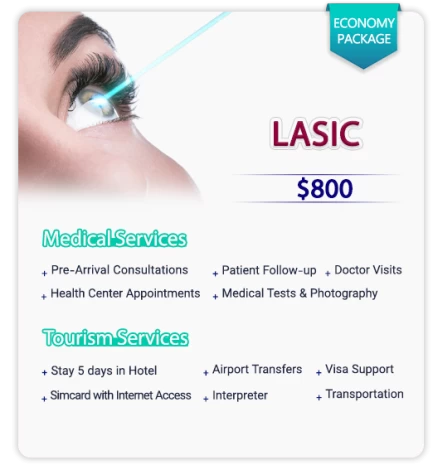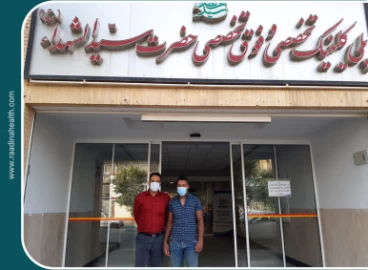LASIK is a relatively new method of refractive surgery through which the problems of nearsightedness, farsightedness, and astigmatism of the eye are eliminated using laser light. Wearing glasses and contact lenses restricts many activities such as photography, reading, swimming, and exercising; so, by doing LASIK surgery, you can have a new taste of life. In this essay, we discuss different methods of eye surgery in Iran and explain its procedure, pros and cons, and aftercare.
What Is LASIK Surgery?
The cornea and lens of the eye direct the light into the eye and focus it on the retina. You can see a clear image of what you are observing. However, if the cornea and lens are damaged, the eye can no longer focus properly, and you will have blurred vision. Laser-Assisted In-Situ Keratomileusis (LASIK) is a kind of eye surgery specifically developed to minimize blurry vision. This surgery is performed to eliminate refractive errors such as astigmatism, nearsightedness (myopia), and farsightedness (hyperopia). In this surgical procedure, the ophthalmologist uses an excimer laser to make necessary corrections to the cornea. After performing LASIK eye surgery in Iran, the patient no longer needs to wear glasses or contact lenses.
Why Iran for Laser Eye Surgery?
As one of the world's main hubs of eye surgery, Iran has many knowledgeable and experienced ophthalmologists and the most advanced and precise laser devices. Moreover, Iran has the most modern and facilitated eye clinics where you can benefit from all kinds of eye care services under one roof. That being the case, many patients from all over the globe prefer to do eye surgery in Iran.
Cost of LASIK Surgery in Iran
The cost of LASIK eye surgery in Iran mainly depends on the type of device used in the surgery and the doctor's experience. On average, the cost of laser eye surgery in Iran ranges between $800 to $1,800. This price includes anesthesia, surgeon’s fee, follow-up medications, doctor’s visit, and clinic services such as post-op optometric examinations and 3D imaging.
The quality of healthcare services and the price of eye surgery in Iran are incomparable to other countries. For example, the cost of LASIK in the USA, Australia, and Canada ranges between $2.500 to $3.000 per eye. In European countries such as Germany, Spain, and the UK, LASIK costs $2.000 per eye.
Types of Refractive Surgery
Today, there are different types of refractive surgeries, the most common of which are:
- LASIK (laser in-situ keratomileusis)
- LASEK (laser epithelial keratomileusis)
- PRK (photorefractive keratectomy).
Depending on your eye number, the specific condition of the eye, corneal thickness, and corneal curvature, the eye surgeon decides which method of refractive surgery is suitable for you.
- LASIK: in this method, a laser device creates a circular flap on the cornea's surface, and the corneal tissue is reshaped. LASIK cannot correct lazy eye and glaucoma, but it is proper for patients with stable eye numbers.
- PRK: in the PRK method, the doctor removes the corneal epithelium (the cornea's outermost layer) instead of creating a corneal flap. It takes three to four days for corneal epithelial to grow back; meanwhile, the patient experiences moderate pain and blurred vision. This method is suitable for the ones who may have eye damage in their daily activities, for example, athletes, police officers, firefighters, miners, etc.;
- LASEK: this type of eye surgery combines LASIK and PRK and is more suitable for people with a very thin cornea.
Types of LASIK Surgery in Iran
In Iran, two types of LASIK surgery are practiced: standard and custom. In the following, these two methods are introduced briefly.
Standard LASIK
This method, known as traditional LASIK and conventional LASIK, was first invented in the 1990s and has been successful until now. This surgery is safe and suitable for people with lower-order aberrations such as myopia, hyperopia, astigmatism, and standard pupil size. The only shortcoming of this method is that, in some cases, the patient may still experience some visual errors after the surgery.
Custom LASIK
In this method, the optical aberration is first detected by a laser device, and then the eye’s deficiency is eliminated by using an advanced and customized surgical device. This surgery is suitable for patients who suffer lower- or higher-order aberrations and those with large pupil sizes. By performing custom LASIK surgery, the patient’s vision will be %100 corrected, and they will not experience any serious complications. However, this method is unsuitable for all patients; people with small pupil sizes, severe astigmatism, and severe myopia are not proper candidates for this surgery.
Best Candidates for Laser Eye Surgery
For undergoing laser eye surgery, you need to have the following features:
- It would be best if you were between the age of 18 and 40;
- It would help if you were not pregnant or breastfeeding because it may change the measured refraction of the eye;
- Your eyes should be healthy. If you have an eye infection, keratoconus, glaucoma, cataract, chronic eye dryness, and autoimmune disorders like rheumatoid arthritis, you should reconsider performing LASIK surgery;
- Your eye number should be stable for at least a year;
- It would help if you had moderate refraction to achieve the best result from LASIK surgery;
- You shouldn’t have serious health problems such as rheumatism or type 1 diabetes;
- The size of your pupils must be standard. If your pupils are too large, you may face some vision deficiency after the surgery;
- The thickness of your cornea should be enough to create the flap. So, if your cornea is too thin, laser eye surgery is not suitable for you; and
- Your eye number must be less than 10.
Best Ophthalmologist for LASIK Surgery in Iran
Although LASIK is a common refractive surgery, it is delicate and should be done by the hands of an accurate and experienced ophthalmologist. Fortunately, Iran has numerous skilled ophthalmologists who are experts in diagnosing the disease as well as treating them. Iranian eye surgeons have all graduated from top medical schools and universities in Iran and around the globe and can enhance your blurred vision in the blink of an eye.
How to Prepare for Laser Eye Surgery
Before laser eye surgery:
- Have a consulting session with your eye doctor and ask them about the procedure of your surgery;
- Provide a complete medical history and perform a necessary eye examination. This may include tests to measure corneal thickness, the severity of refraction, and eye pressure;
- Your surgeon may provide a map of your cornea and dilate your pupil before the surgery;
- Stop wearing contact lenses from a week before the surgery;
- Have a light meal on the day of the surgery;
- Do not have caffeinated and alcoholic drinks before the operation;
- Do not wear makeup, perfume, or hair accessories on the day of the LASIK surgery;
- Do not use moisturizers, lotion, and products containing alcohol;
- Take a shower a day before the surgery and wash your eyelids with a gentle face wash right before the operation;
- Reduce screen time the night before the surgery;
- Ask someone to be your caregiver for a couple of days; and
- Get UV400 sunglasses because they block UV rays for %100.
Procedure of LASIK Surgery in Iran
LASIK is an outpatient surgery; the only anesthetic used in this operation is an eye drop that numbs the eye's surface. Since during laser eye surgery, the eyes get wet, a special ring is placed around the eyelid to prevent eye movement. During the operation, you will be asked to look directly at a point of red light.
Then, the surgeon removes your corneal flap and reshapes the cornea. After that, the surgeon returns the flap to its original position. The flap attaches to its desired place without sutures. At last, a bandage contact lens (BCL) is placed on the cornea to protect it from edema, dry eye, and friction.
LASIK Eye Surgery Aftercare Instructions
Immediately after LASIK surgery, you will be discharged from the hospital, and you can rest at home. Since you don’t have a good vision right after the operation, ask someone to drive you home.
For a couple of days after laser eye surgery, your eyes will be dry and irritated. At this time, you must take eye drops to prevent infection and inflammation and keep your eyes moist. You may feel slightly burning when using them, but that is normal. Your eyes will probably heal very quickly, and your vision will get better within a few days; meanwhile, consider the following aftercare:
- Visit your eye doctor a day after the surgery to get your eyes checked;
- Take the prescribed medications according to the instructions;
- Do not rub your eyes;
- Do not use cosmetics around the eyes for up to two weeks;
- When sleeping, make sure that you do not apply pressure on your eyes;
- Do not wash your face or bathe for up to three days;
- Wear sunglasses even at home and while watching TV or using a cellphone;
- Do not lift objects heavier than two kilograms;
- Avoid swimming and using the Jacuzzi for a month after the surgery; and
- Protect your eyes from dust, bright light, and pollution.
Possible Complications of Laser Eye Surgery
Although laser eye surgery is not painful, you may experience some complications after the operation. Some of these side effects may persist for several weeks, but most disappear a few days after the surgery.
- Dry eye syndrome (DES);
- Sensitivity to light;
- Diplopia;
- Having bad vision at night for a few days to a few weeks after the surgery;
- Overcorrection and under-correction may cause focusing problems in people with myopic;
- Inflammation and infection; and
- Irreversible vision loss. In rare cases, errors during the surgery (such as laser device malfunction) or postoperative complications (such as inflammation) may cause irreversible damage to the eye, including permanent blindness or reduction in vision.
Advantages of Laser Eye Surgery
Laser eye surgery, as one of the most popular methods of refractive surgery, has numerous benefits such as:
- Rapid vision recovery;
- Everlasting improvement in eyesight;
- Having almost no pain;
- Having no stitches;
- Having low complication rate;
- You don’t need to wear glasses and contact lenses anymore;
- In case of having blurry vision after a few years, the doctor can recorrect it; and
- You don’t need to take medication long after the surgery.
Disadvantages of LASIK Surgery
In addition to all its advantages, LASIK surgery has disadvantages that make some hesitate. Some of these demerits include:
- A small number of patients will have their blurry vision return after a few years;
- Sometimes during the surgery, corneal damage may occur that is irreparable;
- In some cases, dry eye syndrome or fear of light (photophobia) may occur;
- It is a rather expensive surgery, and some insurances do not cover the cost of it;
- Some patients will have double vision after the operation; and
- In certain exceptional cases, the quality of vision decreases during the night after the surgery.
FAQs about LASIK Eye Surgery in Iran
1) How long does LASIK surgery take in Iran?
Depending on your eye number and the required correction, LASIK eye surgery in Iran usually takes less than 10 minutes for each eye. However, you should be in the eye clinic for about 1/5 hour on the day of the surgery.
2) Is LASIK surgery painful?
LASIK surgery is not painful because, before the operation, your eye is numbed with anesthetic eye drops. You may feel a slight pressure around your eyes during the temporary laser operation. After the surgery, apply some eye drops to reduce dryness in your eyes and minimize the discomfort caused by itching and tearing.
3) How long after LASIK surgery can I see?
Depending on your eye number and the type of your cornea, it takes a day to a week for your vision to come back. Most patients resume their daily activities from one to two days after surgery, but it may take one to two months for your vision to fully stabilize.
4) How soon after LASIK surgery can I drive?
Usually, the patients can drive two days after LASIK surgery, but it is recommended not to drive until their vision is obvious.
5) Is it possible to operate both eyes in one session of LASIK surgery?
Yes. Usually, both eyes are treated in one surgical session, but the surgeon sometimes waits several weeks for the results of the other eye to be determined.
6) How long should I stay in Iran after LASIK surgery?
LASIK surgery is an outpatient operation, and you will be discharged from the hospital right after the surgery. However, resting at home or hotel for a couple of days is suggested before going back home since your eyes may be irritated and itchy for some days.
7) What Is the best age for LASIK surgery?
Although you can perform LASIK surgery from 18, most specialists believe that the ideal age for doing this surgery is between 24 to 40 because the eye prescription is stable during this period.




comments
No reviews